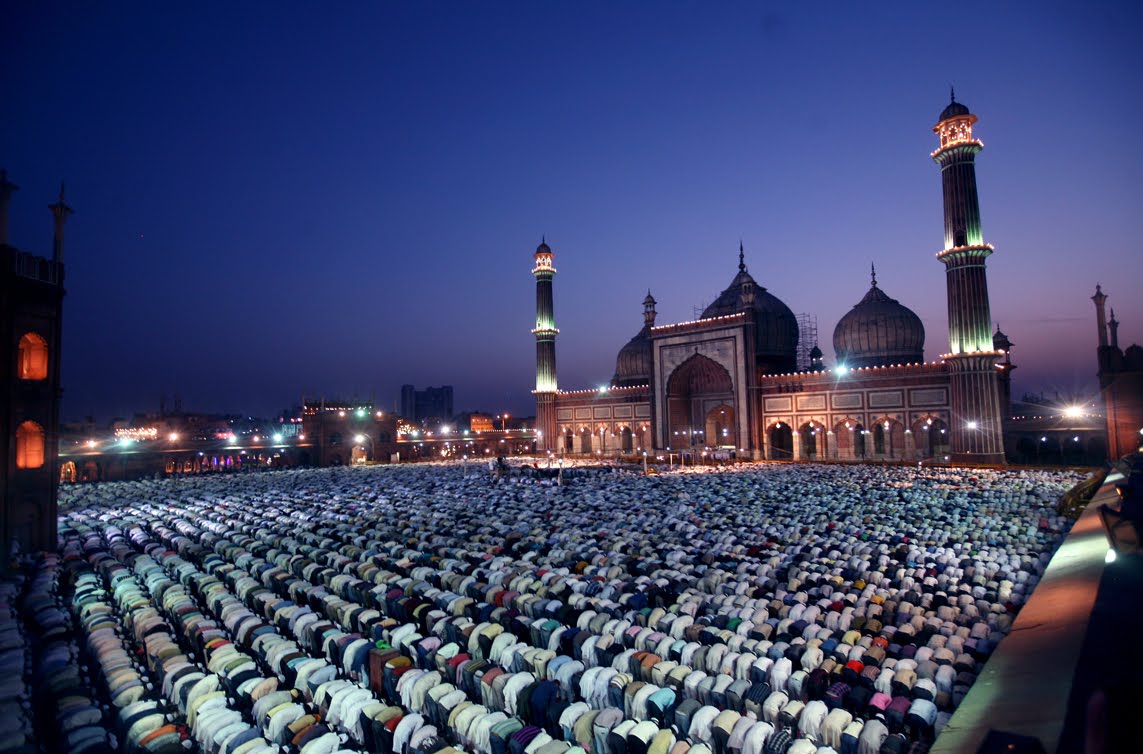More course descriptions to appear soon

Jama Masjid, Delhi, India : built by Mughal emperor Shah Jahan in 1656 AD. The courtyard can accommodate more than 25,000 persons.
|
100 Level Courses |
200 Level Courses |
300 & 400 Level Courses |
Arabic 101 is an introduction to Modern Standard Arabic. By means of a communicative and proficiency-based approach, students will develop basic communicative skills in the language through a combination of interactive classroom activities, take-home assignments and group work. This course is designed for beginners of Arabic and aims to develop students' listening, speaking, reading and writing skills in Arabic. The course will provide students with an opportunity to learn basic vocabulary and basic grammatical structures of Arabic. Students will also be introduced to various aspects of Arabic culture. In addition, this course will teach learners how to speak formal as well as colloquial Arabic language; these aspects will be introduced in meaningful cultural contexts.
HIST 112B 005-008 Modern World History 1500-present (Steve Tamari)
This course introduces students to modern world history in a manner that is both narrative (following a chronological ordering of major historical developments) and explanatory (using the advent of capitalism to explain why these particular developments took place). As a course that strives to cover as much of the globe as possible in one semester, HIST 112B zeroes in on the multiplicity of perspectives represented by a host of “voices” coming from all corners of the globe. Most Americans are taught that the world’s modern history is largely a product of changes that originated in Europe, such as the “discovery” of the Americas, the Scientific Revolution, the French Revolution, the Industrial Revolution, colonialism, the two world wars, and the Cold War. This course, by contrast, aims to introduce students to an interpretation of world history that is global rather than Eurocentric. Finally, as a course that brings us close to the present, this course is designed to challenge students to situate contemporary events—such as 9-11, the wars in Afghanistan and Iraq, and the economic recession—within their proper global context. Students will be encouraged to grapple with the ways in which their own history as citizens of an imperial power meshes with that of the world at large, particularly the Third World.
GEOG 333 - Geography of Asia (Bin Zhou)
Physical settings and geographic patterns of human activities with area descriptions of Asian countries and particular regions stressing human and environmental relationships.
HIST 354A Islamic Middle East, 600-1400 CE (Steve Tamari)
This course has two main goals. The first is topical and aims to introduce students to the major themes in pre-modern Islamic history. These themes include: the formative period of Islamic history in the Middle East (600- 1000 CE) with special reference to competing political and intellectual trends; the era of political fragmentation (950-1250 CE) including the encounter with the West during the Crusades; and the development of cultural unity across the areas controlled by Muslims by the 15th century. The second main goal of the course is to challenge students to develop their skills as active listeners, critical readers and as persuasive writers through the analysis of primary and secondary texts.
HIST 354C Twentieth-Century Middle East (Steve Tamari)
What is the Middle East? Who are Middle Easterners? Are they that different from us? What are the cultural, religious, social, and political factors that connect Middle Easterners and what are those that divide them? Why is there such ambivalence (if not open hostility) to the US in this part of the world? Why did a group of Middle Easterners attack the US on 9/11? What caused the uprisings (known as the “Arab Spring”) in 2011? The course is premised on the idea that the history of the 20th-century Middle East is complicated but not irrational. We will strive to answer such questions above and others students may have. We will be reading lots of first-person memoirs and connecting those to overviews of the region during this critical century. In addition to reading, lectures, and discussions we will use film and writing exercises to deepen our exploration of this region.
IS 354 Islam and Politics (Saba Fatima and Steve Tamari)
This course is an examination of Islamic political thought and experience in both a historical and philosophical context. It seeks to provide both an overview of key ideas and themes that have informed mainstream Islamic politics as well provide an engagement with influential thinkers and texts that have shaped history. Historically, students will become familiar with the broad arc of Muslim history from the career of the Prophet Muhammad through the establishment of Muslim dynasties, the key political role played by Muslim scholars (the ulama), and the encounter between Muslim populations and European colonial regimes and American imperialism in the modern period. Philosophically, we will examine the tension between an all-encompassing religion and democracy, the moral basis of legitimate political authority, just war theory, gender within Islam, the relationship between the West and Islam, and the more recent issue of racializing the Muslim identity in the United States. The ultimate objective of the course is to understand the symbiotic relationship between historical events and philosophical ideas through interdisciplinary study.
PHIL 334 World Religion (Saba Fatima)
This course examines many of the major religious traditions of the world in terms of their history, worldviews, practices, goals and ideals. We will cover: primal religions, Hinduism, Buddhism, Confucianism, Taoism, Judaism, Christianity, Islam, Nation of Islam and Atheism. We will familiarize ourselves with the diversity of belief systems and contextualize them within history.
PHIL 335 Islamic Thought (Saba Fatima)
The course will introduce Shi`a Islamic doctrine, specifically the Ithna-'Ashari (Twelver) denomination, as it is the most developed and influential Shi’ite legal school (madhhab). There will be particular attention to relations between Sunnis and Shias, and we will delve into the historical reasons for the division. The course will also familiarize students with basic tenants of Shia theology and their implications for present day.